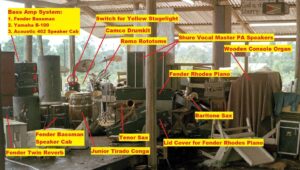(Joel X. Thomas has been a lifelong musician, performer, and recording artist. He is also a regular contributor to the jonestown report. His other investigative articles in this edition are The Jonestown Radio Tower (It’s not what you think), The Infrastructure of Jonestown’s Recording and Speaker Systems: A Photographic Overview, and Mystery of Q042 Death Tape Unspooled. He is also the author of The Most Recent Jonestown Book Cannot Be the Last. His complete collection of articles for this site is here. He can be reached at joelxthomas@hotmail.com.)
(Editor’s note: There are two videos accompanying this article. They both contain the raw footage of the performance of the Jonestown Express band on the night of November 17.
The difference between them is that the first is the video as the NBC camera crew shot it, and includes no annotations.
The second includes labels and captions as various people appear in it, ranging from band members to people sitting in the audience.
The time stamps which appear throughout the piece below indicate when an identified individual appears.)
It is well known that, on the night of November 17, 1978, Deanna Wilkinson and the Peoples Temple band known as the Jonestown Express performed in the pavilion, as Rep. Leo Ryan and everyone who had accompanied him to Jonestown sat in the audience. We know who some of the musicians were who backed up Deanna’s singing. But what instruments did they play? What was the stage set-up? How did the NBC camera crew filming the event enhance – or alternately, detract – from the quality of the performance?
In other words, beyond the quality of Deanna’s singing, what does that night say about the music in Jonestown?
The stage itself was the same platform that Jim Jones used for meetings and rallies, although that night, his throne-like chair and table had been moved off to make room for the performers and musicians.
A small Shure Vocal Master model VA 302-C Console PA system was set up on the left side of the stage, with a speaker column sitting towards the back left, and a speaker column sitting on the right, for the performers’ audio.
The lighting for the pavilion was usually provided by fluorescent tubes, although – another change that night – the normal stage lighting was turned off, since fluorescent tubes cause interference and 60 cycle hum through any type of sound system. Instead, a single yellow incandescent spotlight hung in the middle of the stage and was turned on during the musical performances and comedy skits. This gave the stage a warm yellow glow. The switch to turn this yellow spotlight on was located on a pole in the far back right corner behind the drumkit.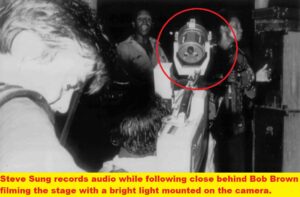 To videotape the performance on the night of November 17, however, the NBC camera crew needed more light, which the camera itself provided. It flooded the stage and surrounding area in a wash of white brightness, which accounts for images of the children squinting as the brightly lit NBC camera tracks by them en route to the stage.
To videotape the performance on the night of November 17, however, the NBC camera crew needed more light, which the camera itself provided. It flooded the stage and surrounding area in a wash of white brightness, which accounts for images of the children squinting as the brightly lit NBC camera tracks by them en route to the stage.
The show was emceed by Greg Watkins, who introduced the night’s performers and songs. Chris Rozynko, known for performing his various comedy skits – which can be seen on many archive Peoples Temple home movies – appears in the audience (0:56).
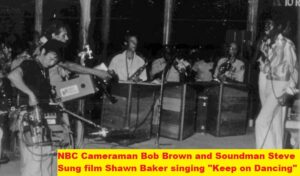 Earlier that night, the NBC crew captured segments of Shawn Baker performing a cover of “Keep On Dancing,” by the Jackson 5.
Earlier that night, the NBC crew captured segments of Shawn Baker performing a cover of “Keep On Dancing,” by the Jackson 5.
But the highlight of the performance features Deanna Wilkinson performing “That’s the Way of the World,” by Earth, Wind and Fire. This upbeat remake by the Jonestown Express is favored by many over the slow, ballad-like original version.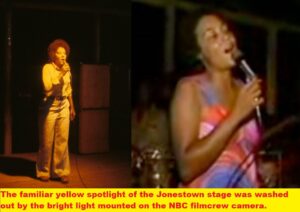 In the video, Deanna stands in the center of the stage, wearing her psychedelic swirled orange, pink and purple dress, singing into a Shure 548S Unidyne IV microphone (1:58).
In the video, Deanna stands in the center of the stage, wearing her psychedelic swirled orange, pink and purple dress, singing into a Shure 548S Unidyne IV microphone (1:58).
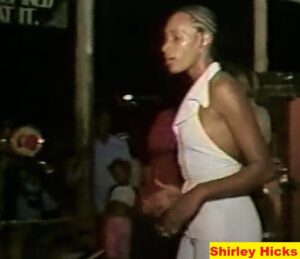 On the left side of the stage, Shirley Hicks – in a white jumpsuit – acts as conductor to the brass section of the band (1:22).
On the left side of the stage, Shirley Hicks – in a white jumpsuit – acts as conductor to the brass section of the band (1:22).
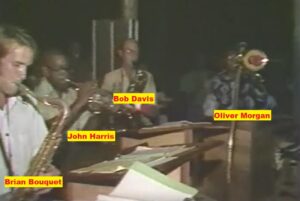 Upfront, Brian Bouquet plays what resembles a 1960’s Selmer Mark 6 tenor sax (1:32). In the middle, John Harris plays a trumpet equipped with a mute (1:36). Beside him towards the rear, is Bob Davis on a 1960’s Selmer SBA low Bb baritone sax (1:38). To the right and in the back of the trio, Oliver Morgan plays a trombone, also equipped with a mute (1:28).
Upfront, Brian Bouquet plays what resembles a 1960’s Selmer Mark 6 tenor sax (1:32). In the middle, John Harris plays a trumpet equipped with a mute (1:36). Beside him towards the rear, is Bob Davis on a 1960’s Selmer SBA low Bb baritone sax (1:38). To the right and in the back of the trio, Oliver Morgan plays a trombone, also equipped with a mute (1:28).
 Behind Deanna is the band’s auxiliary percussion section. Sharon “Tobi” Stone plays the tambourine, eventually changing to a handheld woodblock (2:38).
Behind Deanna is the band’s auxiliary percussion section. Sharon “Tobi” Stone plays the tambourine, eventually changing to a handheld woodblock (2:38).
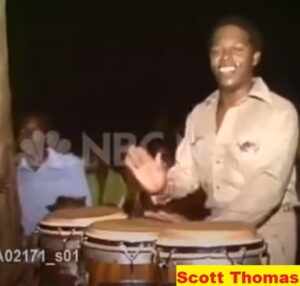 To the right of her is Scott Thomas, playing three Junior Tirado congas (2:30).
To the right of her is Scott Thomas, playing three Junior Tirado congas (2:30).
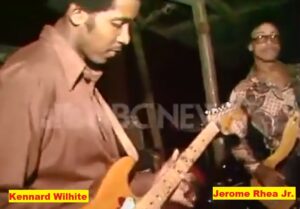 On the right side of the stage, Kennard Wilhite plays a yellow Fender Stratocaster (Strat) guitar, fitted with a humbucking pick-up in the neck position, plugged into a Fender Twin Reverb amplifier that sits on the floor (2:44). Beside him is Jerome Rhea Jr., playing a yellow Fender Precision bass guitar.
On the right side of the stage, Kennard Wilhite plays a yellow Fender Stratocaster (Strat) guitar, fitted with a humbucking pick-up in the neck position, plugged into a Fender Twin Reverb amplifier that sits on the floor (2:44). Beside him is Jerome Rhea Jr., playing a yellow Fender Precision bass guitar.
Behind Jerome is an assortment of bass amps (2:49). On the top of the stack is a 100 watt, tube-driven Fender Bassman bass amplifier head. Sitting underneath that is a solid state Yamaha B-100 amp head. They both perch atop an Acoustic 402 bass speaker cabinet. Also on the floor in front is a blonde Fender Bassman 2×12 bass speaker cabinet. This setup could essentially serve as two completely different bass amplifier systems, to accommodate Jonestown’s multiple musicians and bands.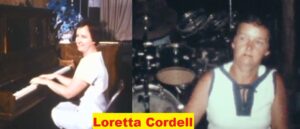 Beside Jerome is keyboardist Loretta Cordell, who had been the Temple’s pianist for years (2:49).
Beside Jerome is keyboardist Loretta Cordell, who had been the Temple’s pianist for years (2:49).
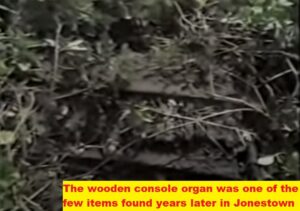 She is sitting behind a “Fender Rhodes Piano-Mark I Suitcase” keyboard. The sound for her electric piano is being projected by the amplifier stand it sits on. This keyboard is totally different from the actual wooden console organ that sat on the ground of the pavilion, off to the right of the stage. The console organ was one of the few items that people returning to Jonestown found years later, but by then, it was only as a pile of rubble.
She is sitting behind a “Fender Rhodes Piano-Mark I Suitcase” keyboard. The sound for her electric piano is being projected by the amplifier stand it sits on. This keyboard is totally different from the actual wooden console organ that sat on the ground of the pavilion, off to the right of the stage. The console organ was one of the few items that people returning to Jonestown found years later, but by then, it was only as a pile of rubble.
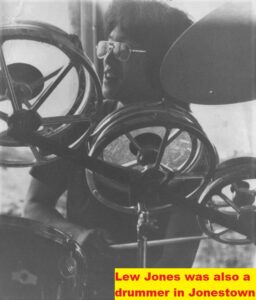 Tucked back into the right corner of the pavilion, was Clifford Gieg playing a Camco 5 piece drumkit with three crash cymbals and a set of 3 Remo rototoms (2:49). The left-most crash cymbal was actually a rivet-crash, typical of drumsets from the 70’s.
Tucked back into the right corner of the pavilion, was Clifford Gieg playing a Camco 5 piece drumkit with three crash cymbals and a set of 3 Remo rototoms (2:49). The left-most crash cymbal was actually a rivet-crash, typical of drumsets from the 70’s. 
The kit has the bottom heads removed from both of its toms. This kit was shared by all the drummers in Jonestown, including Lew Jones, who appears in other photos playing this same set.
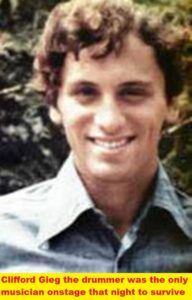 Out of all the musicians onstage, Clifford Gieg was the only person not to die the following day. He survived by being on a Temple boat on the Kaituma River with Herbert Newell. He is also the only musician not visible in the video. (12a)
Out of all the musicians onstage, Clifford Gieg was the only person not to die the following day. He survived by being on a Temple boat on the Kaituma River with Herbert Newell. He is also the only musician not visible in the video. (12a)
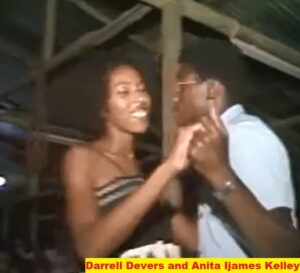 Throughout the song’s performance, a couple – Darrell Devers and Anita Ijames Kelley – dances gracefully in front of the stage (3:40).
Throughout the song’s performance, a couple – Darrell Devers and Anita Ijames Kelley – dances gracefully in front of the stage (3:40).
When watching the NBC footage, it is important to keep in mind that Bob Brown operated the camera, with soundman Steve Sung trailing closely behind. Steve carried the battery power and the recording equipment for Bob’s camera, and they were tethered together by a short cable. Steve also wielded a long boom with microphone at the far end. This is important when it comes to the audio sometimes not seeming to match the video – at times, certain instruments come through better than others, even though they may not appear in the video frame – since the camera may be pointing one way, and the microphone would be aimed in a completely different direction.
Another aspect of the audio is the placement of the Shure Vocal Master PA speakers. The musical performances audio set-up was totally different from the set-up of a normal rally or meeting. On those occasions, the inside of the pavilion was wired with four PA speaker columns that hung on support poles. During a musical performance, however, the Shure Vocal Master PA was used, with the speakers placed on the stage as a monitor for the band and as an overall amplifier for the audience. The drums, guitars, keyboard, and percussion produced their own “stage sound,” whereas the microphones for the singers, and a microphone over the brass section were run through the Shure Vocal Master PA. The PA system had six channels to adjust the microphone sound levels to match the stage sound levels.
Finally, the audio of the NBC video is greatly affected by the camera crew walking between these onstage PA speakers and the microphone boom stand. Sometimes Deanna is inaudible when the camera is pointing directly behind her. Once again, this is the result of the microphone recording the sound, being pointed in a direction opposite as to what the camera is filming.
Overall, this video recording is one of the most haunting and beloved videos to have come out of Jonestown. Yet the hope and enthusiasm that the people show here turns out to be a preamble to the horrors of the following day. But perhaps one day the talent, the creativity, and the passion – in short, the life – of the Jonestown community will be become its more enduring legacy.
